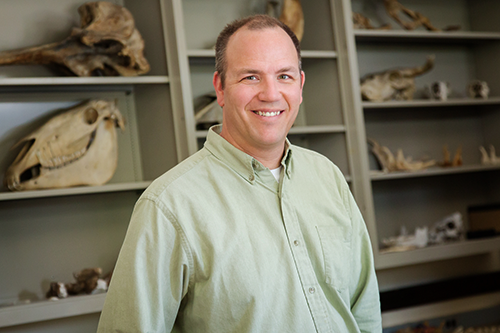

It’s called the latitudinal diversity gradient, a phenomenon seen today in most plant and animal species around the world: Biodiversity decreases from the equator to higher latitudes. But a new study of fossils representing 63 million of the past 65 million years reveals that—for North American mammals, at least—the modern LDG is the exception rather than the rule.
The findings, reported in the Proceedings of the National Academy of Sciences, point to the importance of not assuming that the way things are today is the way they’ve always been, the researchers say.
“If you go back a few thousand years ago, before we lost a lot of the large mammals that we had in North America, and probably for millions or tens of millions of years before this, we had horses in the higher latitudes, we had mammoths, we had rhinoceroses. Things that you find mostly in southern latitudes today, we had in northern latitudes as well,” said Jonathan Marcot, a University of Illinois animal biology professor who conducted the study with David Fox and Spencer Niebuhr of the University of Minnesota.
The findings come on the heels of a 2011 study by Marcot, Fox, and other colleagues that examined North American mammal fossils from 58 million to 63 million years ago found no evidence of a latitudinal diversity gradient for North American mammals at that time, which was only a few million years after the extinction of non- avian dinosaurs.
A look at oxygen isotope ratios in the bones, which can be used to determine ancient temperatures, found evidence that the temperature gradient during that time period, the Paleocene, was similar to that of modern times.
“There was no biodiversity gradient back then as there is now,” Marcot said. “Our question in the new study was, when did it change and how did it change?”
To answer this, the team turned again to the fossil record, this time looking at 27,903 fossil occurrences in all latitudes of North America representing 63 million years of mammalian life—from the time of the dinosaur extinctions to 2 million years ago. They compared mammalian species diversity at every latitude and every time period for which sufficient data were available. They also analyzed diversity in relation to the record of temperature changes over the same time period.
“What we found is that for most of the time that we considered, from 65 million years ago to about 10 million years ago, there was no strong evidence for a gradient,” Marcot said. “There were roughly as many animal species in the northern parts of North America as there were in the southern regions.”
Between 10 million and 4 million years ago, “we start to see a strengthening of a gradient,” he said. “And finally, we found strong evidence for a negative gradient—that is, more species in the south than in the north—starting around 4 million years ago.”
The new findings point to the importance of not only studying living organisms but also considering the fossil record of past life and environments, Marcot said.
Humans can learn a lot from life on Earth today, he said. “But given how much we know climates have changed and species have changed, there’s no reason to suspect that the patterns we find today necessarily will have applied 10, 20 or 100 million years ago. If we understand what things were like then and what they’re like now, we can begin to understand how Earth is connected to life and how they change together.”
The National Science Foundation supported this research.


